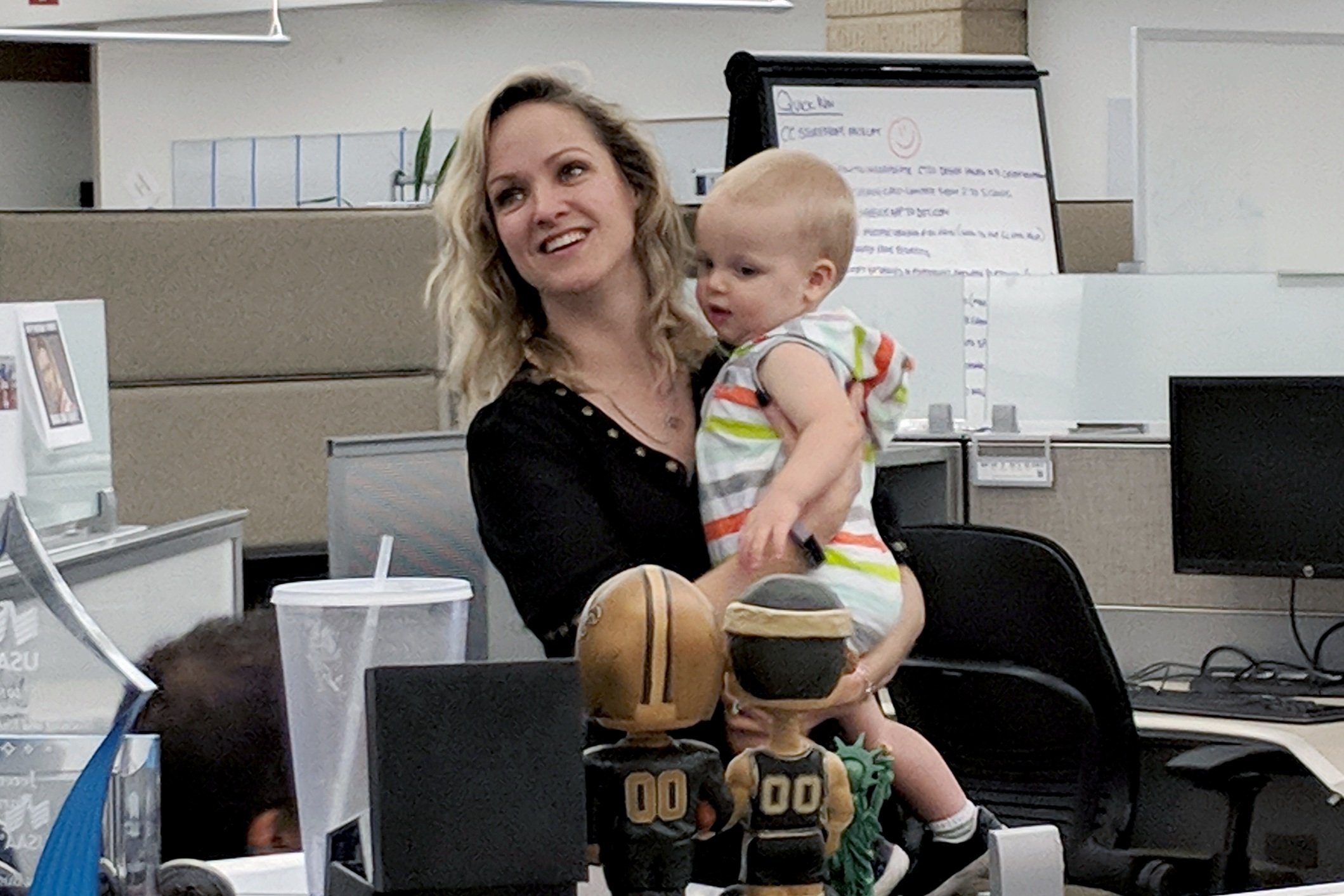Let’s Make 2025 the Year of Paid Parental Leave
By Vanessa Jupe, CEO of Leva
In this photo, Vanessa is visiting the office with her baby, Roosevelt, before she returns from paid leave.
As a mom and the founder of Leva, I’ve seen firsthand the challenges families face during the transition into parenthood. I am sure that you, as HR leaders, have, too. Sleepless nights, physical recovery, emotional overwhelm, and financial stress weigh heavily on new parents. But the workplace often adds another burden: unpaid leave policies that force employees to choose between their families and their livelihoods. It doesn’t have to be this way.
The U.S. is the only wealthy nation without a federal paid leave policy. Meanwhile, other countries provide the support families need to thrive, and they’re reaping the rewards of healthier, more engaged workforces.
For some reason, here in the US, we cling to the outdated notion that families should shoulder this burden alone. Let’s set the record straight: Paid Leave is a Fundamental Human Right and a Business Imperative.
2025 must be the year we finally say "enough."
We need a federal paid leave policy that reflects our values, supports our families, and strengthens our economy. While the Paid Parental Leave Act is not currently in Congress, some related bills in the 119th Congress do aim to expand paid family leave benefits. These include:
Progress is Happening—But We Need to Do More
While some companies and states have taken the lead on paid leave, lacking a federal policy leaves too many families unsupported. More and more states are implementing their own paid leave programs, proving it can be done. (Check out our full list of state-specific paid leave programs.) Public support is overwhelming, with people across the political spectrum demanding change. In fact, 76 percent of Americans say it is important that Congress create a national paid family and medical leave program. Several proposals are gaining momentum, including:
The FAMILY Act: A national program offering 12 weeks of partial income for qualifying events like childbirth or serious health conditions.
The Healthy Families Act: A proposal requiring employers with 15+ employees to provide 7 days of paid sick leave annually.
The Federal Employee Paid Leave Act (FEPLA): Currently offering 12 weeks of paid parental leave for federal employees, with discussions about expanding to military families.
These efforts are a start, but we can’t stop here. HR professionals have the power to advocate for meaningful change both inside their organizations and at the policy level.
Why Paid Leave is a Win-Win for Employees and Employers
Paid parental leave isn’t just the right thing to do—it’s also smart business. Studies show that paid leave:
Reduces turnover: Replacing an employee can cost up to twice their annual salary. Paid leave improves retention, especially among working parents.
Boosts productivity: Employees who feel supported at work are more engaged and less likely to experience burnout.
Attracts top talent: Companies offering paid leave stand out in competitive job markets and appeal to younger generations prioritizing work-life balance.
Moments like the one captured in the photo above, where I brought my son Roosevelt to the office at the end of our 3-month paid leave together, remind me why paid leave is so important. Supporting families at work isn’t just about policies; it’s about creating a culture where parents feel seen, valued, and empowered. With the right support, employees don’t have to choose between their families and their careers—they can thrive in both. The good news is that if we shift how we manage paid leave, the burden doesn’t have to be borne by businesses alone. Smart policies and creative solutions like public-private partnerships or shared funding models can make paid leave both achievable and sustainable.
What You Can Do as an HR Leader
Paid leave policies may feel like a government issue, but we all have a role to play in driving change.
Start with What You Can Control: Review your organization’s parental leave offerings. Are they competitive? Do they reflect your company’s commitment to employee well-being? Work with your management team to evolve your policies as needed. Even small steps, like offering partial paid leave or flexible schedules, can make a big difference for employees.
Speak Up. Call or email your representatives. Let them know you support paid leave and ask them to prioritize it. Use your influence to support federal policies like the FAMILY Act. Share insights with your networks, and make the business case for why paid leave benefits everyone.
Start Conversations. Talk to friends, family, and colleagues about the importance of paid leave. Share stories to spread awareness and build momentum.
The Future is Paid Leave
2025 can be the year we finally prioritize working families. It’s the year we can say, “We value your contributions and your well-being.”
Every day that passes without federal paid leave is another day that families struggle, women are held back, and our nation falls further behind. As HR leaders, you have the opportunity to shape workplaces that not only attract and retain top talent but also foster a culture of support and equity. Together, we can make paid leave a reality for all employees because when families thrive, so do businesses.
-
Description text goes here
"Family and Medical Insurance Leave (FAMILY) Act." Congress.gov, 2023, https://www.congress.gov/bill/117th-congress/house-bill/804. Accessed 19 Jan. 2025.
"Paid Leave Research and Analysis." U.S. Department of Labor, 2023, https://www.dol.gov/agencies/wb/resources/paid-leave. Accessed 19 Jan. 2025.
"Paid Family Leave Overview." California Employment Development Department, 2023, https://edd.ca.gov/Disability/Paid_Family_Leave.htm. Accessed 19 Jan. 2025.
"Parental Leave Policies Database." Organisation for Economic Co-operation and Development (OECD), 2023, https://www.oecd.org/els/family/database.htm. Accessed 19 Jan. 2025.
"Americans’ Views on Paid Family and Medical Leave." Pew Research Center, 7 Feb. 2023, https://www.pewresearch.org/fact-tank/2023/02/07/majority-of-americans-support-paid-family-and-medical-leave/. Accessed 19 Jan. 2025.
"Paid Leave is Good for Business." National Partnership for Women & Families, 2023, https://www.nationalpartnership.org/our-work/resources/economic-justice/paid-leave/paid-leave-good-for-business.pdf. Accessed 19 Jan. 2025.
"Global Gender Gap Report 2023." World Economic Forum, June 2023, https://www.weforum.org/reports/global-gender-gap-report-2023. Accessed 19 Jan. 2025.
-
Description text goes here
-
Description text goes here


